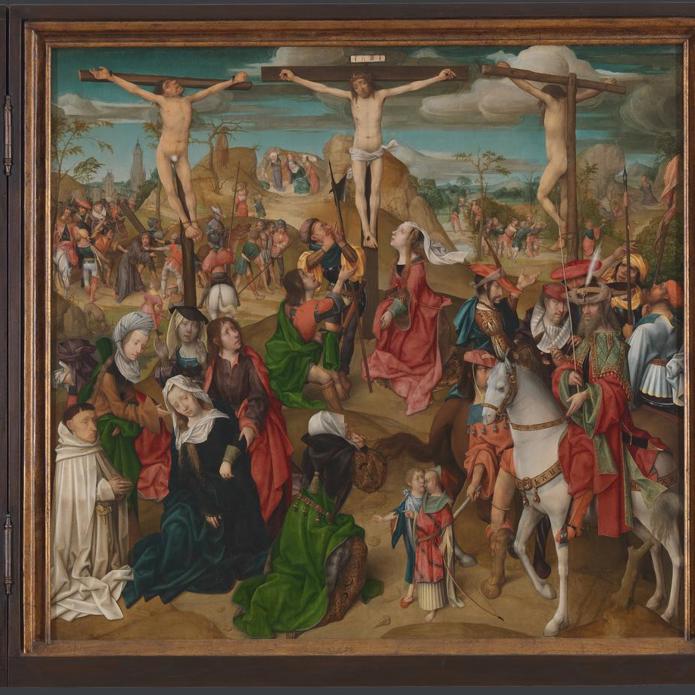Master of Delft, 'The Crucifixion: Central Panel', about 1510
About the work
Overview
This painting is so crowded it takes a while to understand everything that is happening, but the nuns for whom it was probably made must have had plenty of time to examine the details. It is the central panel of a triptych (a painting made up of three parts) painted around 1510, probably for the convent of Koningsveld near Delft.
We see the story of Christ’s crucifixion. In the centre, Christ hangs from the Cross between the two thieves who were executed alongside him, while Mary Magdalene gazes up from the base. On the left are the Virgin Mary and Saint John with several grieving women; facing them on horseback is Roman governor Pontius Pilate, who ordered Christ’s execution. The patron, dressed in a white habit, kneels in the bottom left corner. In the background are events leading up to the Crucifixion.
Key facts
Details
- Full title
- The Crucifixion: Central Panel
- Artist
- Master of Delft
- Artist dates
- active early 16th century
- Part of the group
- Triptych: Scenes from the Passion of Christ
- Date made
- about 1510
- Medium and support
- oil on wood
- Dimensions
- 98.2 × 105 cm
- Acquisition credit
- Presented by Earl Brownlow, 1913
- Inventory number
- NG2922.1
- Location
- Not on display
- Collection
- Main Collection
- Previous owners
- Frame
- 20th-century Replica Frame
Provenance
What was almost certainly the same triptych was by 1846 in the collection of John Rushout (1770–1859), 2nd Baron Northwick, at Thirlestane House, Cheltenham. No. 436 of the 1846 catalogue and no. 474 in the 1853 and 1854 catalogues, it was lot 83 in the Northwick sale there (Phillips) on 26 July 1859, when it was described as ‘MARTIN SCHOEN. A Triptique representing the Crucifixion, Christ leaving the Judgment Hall, and the Taking down from the Cross … In a mahogany case, the outer door enriched with figures of Saints en grisaille’. It was bought by Colnaghi.
In 1913 it was stated that NG 2922 had been ‘purchased by Earl Brownlow in London about 1860’. When it was exhibited in 1893, it was attributed to Schongauer. Adelbert Wellington Brownlow Cust (1844–1921), who succeeded his brother as 3rd Earl Brownlow in 1867, kept the triptych at Ashridge in Kent and presented it to the Gallery in 1913.
Additional information
Text extracted from the ‘Provenance’ section of the catalogue entry in Lorne Campbell, ‘National Gallery Catalogues: The Fifteenth Century Netherlandish Schools’, London 1998; for further information, see the full catalogue entry.
Bibliography
-
1945Davies, Martin, National Gallery Catalogues: Early Netherlandish School, London 1945
-
1955Davies, Martin, National Gallery Catalogues: Early Netherlandish School, 2nd edn (revised), London 1955
-
1967M.J. Friedländer, Early Netherlandish Painting, eds N. Veronée-Verhaegen and H. Pauwels, trans. H. Norden, 14 vols, Leiden 1967
-
1987Davies, Martin, National Gallery Catalogues: The Early Netherlandish School, 3rd edn, London 1987
-
1998Campbell, Lorne, National Gallery Catalogues: The Fifteenth Century Netherlandish Paintings, London 1998
-
2001
C. Baker and T. Henry, The National Gallery: Complete Illustrated Catalogue, London 2001
-
2002Oliver Bradbury and Nicholas Penny, 'The Picture Collecting of Lord Northwick: Part I', The Burlington Magazine, CXLIV/1193, August 2002, pp. 485–96
Frame
This is a replica frame, made at the Gallery in 1975. Crafted from oak, it was inspired by the frame for a sixteenth-century Flemish-style triptych. Decorative hinges from a previous nineteenth-century frame were reused to connect the double-sided panels.
The frame was first shown with its natural colour. In 1999 the frame was stained, and the sill and inner moulding were gilded.
About this record
If you know more about this painting or have spotted an error, please contact us. Please note that exhibition histories are listed from 2009 onwards. Bibliographies may not be complete; more comprehensive information is available in the National Gallery Library.
Images
About the group: Triptych: Scenes from the Passion of Christ

Overview
The story of the Passion (Christ’s torture and crucifixion) unfolds across three crowded panels. On the left, Christ is led out from his trial; in the centre he has been crucified; to the right, his dead body is taken down from the Cross.
The sacred events seem to be taking place near the city of Delft: we can see the tower of its New Church in the background of the centre panel. The triptych (a painting made of three parts) was probably made for the convent of Koningsveld, just outside Delft. The man wearing a white habit and kneeling at the front of the centre panel is likely to be Herman van Rossum, provost of Koningsveld, who may have commissioned the triptych for the high altar in around 1510.



